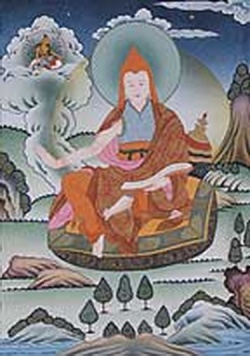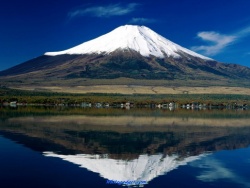Difference between revisions of "Shentong"
| Line 1: | Line 1: | ||
[[File:Mo es.jpg|thumb|250px|]] | [[File:Mo es.jpg|thumb|250px|]] | ||
<poem> | <poem> | ||
| − | '''Shentong''' is a philosophical sub-school found in [[Tibetan Buddhism]]. Its adherents generally hold that the nature of mind, the substratum of the [[Mindstream]], is "empty" (tong; Wylie: stong) of 'other' (shen or zhän; Wylie: gzhan), i.e., empty of all qualities other than an inherent, ineffable nature. The contrasting Rangtong view of the followers of [[Prasaṅgika]] Mādhyamaka is that all phenomena are unequivocally empty of self-nature, without positing anything beyond that. According to a Shentongpa (proponent of Shentong), the emptiness of ultimate reality should not be characterized in the same way as the emptiness of apparent phenomena because it is prabhāsvara-[[Saṃtāna]], or "clear light mental continuum," endowed with limitless Buddha qualities. It is empty of all that is false, not empty of the limitless Buddha qualities that are its innate nature. | + | '''[[Shentong]]''' is a [[philosophical]] sub-school found in [[Tibetan Buddhism]]. Its adherents generally hold that the [[nature of mind]], the [[substratum]] of the [[Mindstream]], is "[[empty]]" (tong; Wylie: stong) of 'other' (shen or zhän; Wylie: gzhan), i.e., [[empty]] of all qualities other than an inherent, ineffable [[nature]]. The contrasting [[Rangtong]] [[view]] of the followers of [[Prasaṅgika]] [[Mādhyamaka]] is that all [[phenomena]] are unequivocally [[empty]] of [[self-nature]], without positing anything beyond that. According to a [[Shentongpa]] (proponent of [[Shentong]]), the [[emptiness]] of [[ultimate reality]] should not be characterized in the same way as the [[emptiness]] of apparent [[phenomena]] because it is [[prabhāsvara]]-[[Saṃtāna]], or "[[clear light]] [[mental]] {{Wiki|continuum}}," endowed with limitless [[Buddha]] qualities. It is [[empty]] of all that is false, not [[empty]] of the limitless [[Buddha]] qualities that are its [[innate nature]]. |
| − | Interpretation of the Madhyamaka texts which emphasized that shunyata was not merely a negative concept, but should be understood as a positive non-dual awareness which could be directly perceived by yogic practitioners. Closely linked with the yogic tradition and tantric practice. The main Shentongpa tradition, the Jonangpa, was suppressed for some centuries by the Gelukpa regime in Central Tibet, who hgeld the opposite (rangtongpa) view, but it was revived by the Rimé teachers in the 19th century. | + | Interpretation of the [[Madhyamaka]] texts which emphasized that [[shunyata]] was not merely a negative {{Wiki|concept}}, but should be understood as a positive [[non-dual]] [[awareness]] which could be directly [[perceived]] by [[yogic]] practitioners. Closely linked with the [[yogic]] [[tradition]] and [[tantric]] practice. The main [[Shentongpa]] [[tradition]], the Jonangpa, was suppressed for some centuries by the [[Gelukpa]] regime in Central [[Tibet]], who hgeld the opposite (rangtongpa) [[view]], but it was revived by the [[Rimé]] [[teachers]] in the 19th century. |
| − | gzhan stong - to put it very simply: whereas the view of rang stong asserts that relative phenomena and appearances are empty (stong) of a self-nature (rang), the gzhan stong view asserts that the ultimate is empty (stong) of any phenomena other (gzhan) than itself [TSD] | + | gzhan stong - to put it very simply: whereas the [[view]] of rang stong asserts that [[relative]] [[phenomena]] and [[appearances]] are [[empty]] (stong) of a [[self-nature]] (rang), the gzhan stong [[view]] asserts that the [[ultimate]] is [[empty]] (stong) of any [[phenomena]] other (gzhan) than itself [TSD] |
| − | chos rje kun mkhyen dol po pa chen po - proponent of Shentong [RY] | + | [[chos]] rje kun mkhyen dol po pa chen po - proponent of [[Shentong]] [RY] |
[[File:Memory min.jpg|thumb|250px|]] | [[File:Memory min.jpg|thumb|250px|]] | ||
| − | jo nang - Jonangpa. The lineage of masters of the Shentong School who were known by their monastery at Jomo Nang. They include Yumo Mikyö Dorje, the founder of the school, Tukje Tsöndrü, Dölpowa Sherab Gyaltsen and Taranatha [RY] | + | jo nang - Jonangpa. The [[lineage]] of [[masters]] of the [[Shentong]] School who were known by their [[monastery]] at Jomo Nang. They include Yumo [[Mikyö Dorje]], the founder of the school, Tukje Tsöndrü, Dölpowa Sherab Gyaltsen and [[Taranatha]] [RY] |
| − | 'jigs med chos skyong zhabs - expounder of Shentong according to the rigs tshogs of Nagarjuna [RY] | + | 'jigs med [[chos]] skyong zhabs - expounder of [[Shentong]] according to the rigs tshogs of [[Nagarjuna]] [RY] |
| − | gzhan stong - Shentong. An aspect of the Madhyamaka School in Tibet focusing on emptiness indivisible from luminosity, asserting that the kayas and wisdoms of buddhahood are naturally present within the sugata essence [RY] | + | gzhan stong - [[Shentong]]. An aspect of the [[Madhyamaka]] School in [[Tibet]] focusing on [[emptiness]] indivisible from [[luminosity]], asserting that the [[kayas]] and [[wisdoms]] of [[buddhahood]] are naturally present within the [[sugata]] [[essence]] [RY] |
| − | gzhan stong dbu ma - the Shentong Madhyamaka School [RY] | + | gzhan stong dbu ma - the [[Shentong]] [[Madhyamaka]] School [RY] |
| − | gzhan stong smra ba - proponent of Shentong [RY] | + | gzhan stong smra ba - proponent of [[Shentong]] [RY] |
| − | rang stong - Rangtong. An aspect of the Madhyamaka school in Tibet focusing on emptiness devoid of inherent existence. Compare with Shentong [RY] | + | rang stong - [[Rangtong]]. An aspect of the [[Madhyamaka school]] in [[Tibet]] focusing on [[emptiness]] devoid of inherent [[existence]]. Compare with [[Shentong]] [RY] |
| − | Etymology | + | {{Wiki|Etymology}} |
[[File:Fre d-mind.jpg|thumb|250px|]] | [[File:Fre d-mind.jpg|thumb|250px|]] | ||
| − | Shentong (also, zhäntong; ), is literally "other-emptiness", i.e., emptiness of other. | + | [[Shentong]] (also, zhäntong; ), is literally "other-emptiness", i.e., [[emptiness]] of other. |
| − | Great Mādhyamaka: a qualification and disambiguation | + | Great [[Mādhyamaka]]: a qualification and disambiguation |
| − | Pettit (1999: p. 113) qualifies and disambiguates "Great Mādhyamaka" and mentions [[Ju Mipham]], [[Longchenpa]], [[Prasaṅgika]] Mādhyamaka, [[Tsongkhapa]] and coalescence: | + | Pettit (1999: p. 113) qualifies and disambiguates "Great [[Mādhyamaka]]" and mentions [[Ju Mipham]], [[Longchenpa]], [[Prasaṅgika]] [[Mādhyamaka]], [[Tsongkhapa]] and coalescence: |
| − | Extrinsic emptiness is also referred to as "Great Mādhyamaka" (dbu ma chen po), a term that appears frequently in Mipham's works. This term can also be misleading, because dbu ma chen po does not refer exclusively to extrinsic emptiness. Klong chen pa and Mipham use it to refer to [[Prasaṅgika]] Mādhyamaka, because it emphasizes the nonconceptual ultimate, which they understand as the principle of coalescence. [[Tsongkhapa]] also uses this term in passing, for example, in the colophon of his dBu-ma dgongs-pa rab-gsal. | + | Extrinsic [[emptiness]] is also referred to as "Great [[Mādhyamaka]]" (dbu ma chen po), a term that appears frequently in Mipham's works. This term can also be misleading, because dbu ma chen po does not refer exclusively to extrinsic [[emptiness]]. Klong chen pa and [[Mipham]] use it to refer to [[Prasaṅgika]] [[Mādhyamaka]], because it emphasizes the [[nonconceptual]] [[ultimate]], which they [[understand]] as the principle of coalescence. [[Tsongkhapa]] also uses this term in passing, for [[example]], in the colophon of his dBu-ma dgongs-pa rab-gsal. |
| − | Shentong: a heterogenous tradition | + | [[Shentong]]: a heterogenous [[tradition]] |
| − | Burchardi (2007: p. 1) opens her foray with a sound introduction, cited herewith, that promises of a future richness and texture in Shentong dialectical discourse in English: | + | Burchardi (2007: p. [[1]]) opens her foray with a [[sound]] introduction, cited herewith, that promises of a future richness and texture in [[Shentong]] [[dialectical]] {{Wiki|discourse}} in English: |
| − | Descriptions of gzhan stong are frequently encountered in the context of polemical discourse, where it stands in contradistinction to rang stong. Some scholarly attention has been paid to the historical context of the controversies involving prominent gzhan stong masters and their writings. But so far the attention given to the actual differences of interpretation of the term gzhan stong in its various hermeneutical and philosophical contexts has been quite limited in non-Tibetan publications – limited, that is, when we consider the extent of primary sources available in Tibetan. | + | Descriptions of gzhan stong are frequently encountered in the context of polemical {{Wiki|discourse}}, where it stands in contradistinction to rang stong. Some [[scholarly]] [[attention]] has been paid to the historical context of the controversies involving prominent gzhan stong [[masters]] and their writings. But so far the [[attention]] given to the actual differences of interpretation of the term gzhan stong in its various {{Wiki|hermeneutical}} and [[philosophical]] contexts has been quite limited in non-Tibetan publications – limited, that is, when we consider the extent of [[primary]] sources available in [[Tibetan]]. |
| Line 43: | Line 43: | ||
[[File:Deer.jpg|thumb|250px|]] | [[File:Deer.jpg|thumb|250px|]] | ||
| − | The earliest Shentong views are usually asserted to have been presented in a group of treatises variously attributed jointly to [[Asanga]] and [[Maitreya]], especially in the treatise known as the "Unsurpassed Continuum" (Uttaratantra Śāstra), and in a body of Mādhyamaka treatises attributed to [[Nāgārjuna]]. | + | The earliest [[Shentong]] [[views]] are usually asserted to have been presented in a group of treatises variously attributed jointly to [[Asanga]] and [[Maitreya]], especially in the treatise known as the "[[Unsurpassed]] {{Wiki|Continuum}}" (Uttaratantra [[Śāstra]]), and in a [[body]] of [[Mādhyamaka]] treatises attributed to [[Nāgārjuna]]. |
| − | The first exposition of a Shentong view is sometimes attributed to Śāntarakṣita, but most scholars argue that his presentation of Mādhyamaka thought is more accurately labeled “Yogācāra-Svatantrika-Mādhyamaka". It is generally agreed that a true Shentong view was first systematized and articulated under that name by [[Dolpopa]] Sherab Gyeltsen, an originally Sakya-trained [[Lama]] who joined the [[Jonang]] school with which Shentong is strongly associated. However, the 11th century Tibetan master [[Yumo Mikyo Dorje]], a student of the Kashmiri scholar Somanatha, was possibly the first Tibetan master to articulate a Shentong view, after his experiences during a [[Kalachakra]] retreat. | + | The first exposition of a [[Shentong]] [[view]] is sometimes attributed to [[Śāntarakṣita]], but most [[scholars]] argue that his presentation of [[Mādhyamaka]] [[thought]] is more accurately labeled “Yogācāra-Svatantrika-Mādhyamaka". It is generally agreed that a true [[Shentong]] [[view]] was first systematized and articulated under that name by [[Dolpopa]] Sherab Gyeltsen, an originally Sakya-trained [[Lama]] who joined the [[Jonang]] school with which [[Shentong]] is strongly associated. However, the 11th century [[Tibetan]] [[master]] [[Yumo Mikyo Dorje]], a student of the Kashmiri [[scholar]] Somanatha, was possibly the first [[Tibetan]] [[master]] to articulate a [[Shentong]] [[view]], after his [[experiences]] during a [[Kalachakra]] [[retreat]]. |
| − | The Seventh [[Karmapa]] Chodrak Gyamtso (1454–1506), and the Sakya scholar, Sakya Chokden (gSer-mdog Pan-chen Sa-kya mChog-ldan, 1428–1507) were also important proponents of a Shentong view. | + | The Seventh [[Karmapa]] Chodrak Gyamtso (1454–1506), and the [[Sakya]] [[scholar]], [[Sakya]] Chokden (gSer-mdog Pan-chen Sa-kya mChog-ldan, 1428–1507) were also important proponents of a [[Shentong]] [[view]]. |
| − | In the [[Jonang]] tradition, "Tāranātha [1575-1635] is second in importance only to [[Dolpopa]] himself. He was responsible for the short-lived renaissance of the school as a whole in the late sixteenth and early seventeenth centuries, and of the widespread revitalization of the Zhentong theory in particular." | + | In the [[Jonang]] [[tradition]], "[[Tāranātha]] [1575-1635] is second in importance only to [[Dolpopa]] himself. He was responsible for the short-lived renaissance of the school as a whole in the late sixteenth and early seventeenth centuries, and of the widespread revitalization of the Zhentong {{Wiki|theory}} in particular." |
[[File:Ing art 00.jpg|thumb|250px|]] | [[File:Ing art 00.jpg|thumb|250px|]] | ||
| − | After the suppression of the [[Jonang]] school and its texts and the texts of Sakya Chokden by the Tibetan government in the 17th century, various Shentong views were propagated mainly by [[Karma Kagyu]] and Nyingma lamas. In particular, the 8th [[Tai Situ Rinpoche]] (Situ Paṇchen Chökyi Jungné (Si-tu Paṇ-chen Chos-kyi 'Byung-gnas) (1700–1774)) and [[Katok Tsewang Norbu]] (Kaḥ-thog Tshe-dbang Nor-bu) (1698–1755), close colleagues and [[Karma Kagyu]] and Nyingma lamas respectively, were very instrumental in reviving Shentong among their sects. Also instrumental was [[Situ Panchen]] (1700–1774), senior court chaplain in the Kingdom of Dêgê, a student of Norbu. According to The Buddha from Dolpo of 2003, "[i]n the end it would be Situ more than anyone who would create the environment for the widespread acceptance of the Zhentong theories in the next century. This revival was continued by [[Jamgon Kongtrul]] Lodro Thaye, a 19th century ecumenical (rimé) scholar and forceful exponent of Shentong. Shentong views were also advanced recently by the eminent [[Kagyu]] Lamas [[Kalu Rinpoche]] and [[Khenpo Tsultrim Gyamtso Rinpoche]]. | + | After the suppression of the [[Jonang]] school and its texts and the texts of [[Sakya]] Chokden by the [[Tibetan]] government in the 17th century, various [[Shentong]] [[views]] were propagated mainly by [[Karma Kagyu]] and [[Nyingma]] [[lamas]]. In particular, the 8th [[Tai Situ Rinpoche]] (Situ Paṇchen Chökyi Jungné (Si-tu Paṇ-chen Chos-kyi 'Byung-gnas) (1700–1774)) and [[Katok Tsewang Norbu]] (Kaḥ-thog Tshe-dbang Nor-bu) (1698–1755), close colleagues and [[Karma Kagyu]] and [[Nyingma]] [[lamas]] respectively, were very instrumental in reviving [[Shentong]] among their sects. Also instrumental was [[Situ Panchen]] (1700–1774), senior court chaplain in the Kingdom of [[Dêgê]], a student of Norbu. According to The [[Buddha]] from Dolpo of 2003, "[i]n the end it would be Situ more than anyone who would create the environment for the widespread acceptance of the Zhentong theories in the next century. This revival was continued by [[Jamgon Kongtrul]] Lodro Thaye, a 19th century {{Wiki|ecumenical}} ([[rimé]]) [[scholar]] and forceful exponent of [[Shentong]]. [[Shentong]] [[views]] were also advanced recently by the eminent [[Kagyu]] [[Lamas]] [[Kalu Rinpoche]] and [[Khenpo Tsultrim Gyamtso Rinpoche]]. |
| − | View | + | [[View]] |
| − | Shentongpas (those who hold a Shentong view) consider their position to be the rarefied expression of Mādhyamika. They hold that this view is the fruit of direct meditative experience and not realised through the path of conceptual understanding nor scholarship. In light of that, they posit that Rangtong is expedient for individuals who approach [[Dharma]] primarily through philosophical studies, whilst Shentong is a means of support for the meditation-oriented practitioner. | + | [[Shentongpas]] (those who hold a [[Shentong]] [[view]]) consider their position to be the rarefied expression of [[Mādhyamika]]. They hold that this [[view]] is the [[fruit]] of [[direct]] [[meditative]] [[experience]] and not realised through the [[path]] of {{Wiki|conceptual}} understanding nor {{Wiki|scholarship}}. In [[light]] of that, they posit that [[Rangtong]] is expedient for {{Wiki|individuals}} who approach [[Dharma]] primarily through [[philosophical]] studies, whilst [[Shentong]] is a means of support for the meditation-oriented practitioner. |
| − | Technical language: twilight language | + | Technical [[language]]: [[twilight language]] |
[[File:Asanga 11969th.jpg|thumb|250px|]] | [[File:Asanga 11969th.jpg|thumb|250px|]] | ||
| − | When speaking of the emptiness of mind's ultimate nature, Shentongpas often use renderings of ösel (Wylie: hod-gsal; od-gsal; Sanskrit: prabhāsvara) such as "luminous clarity," "luminous awareness," "the clear light nature of mind," and so forth to characterize their experiences. Such language is often employed in Dzogchen expositions as well. | + | When speaking of the [[emptiness]] of mind's [[ultimate nature]], [[Shentongpas]] often use renderings of [[ösel]] (Wylie: [[hod-gsal]]; [[od-gsal]]; [[Sanskrit]]: [[prabhāsvara]]) such as "[[luminous clarity]]," "luminous [[awareness]]," "the [[clear light]] [[nature of mind]]," and so forth to characterize their [[experiences]]. Such [[language]] is often employed in [[Dzogchen]] expositions as well. |
| − | Shentong and Rangtong: a continuum, a coalescence | + | [[Shentong and Rangtong]]: a {{Wiki|continuum}}, a coalescence |
| − | Fundamental [[Wisdom]] (Mūlamadhyamakakārikā) by [[Nāgārjuna]], 13.8 has: | + | Fundamental [[Wisdom]] ([[Mūlamadhyamakakārikā]]) by [[Nāgārjuna]], 13.8 has: |
| − | śūnyatā sarvadriṣṭīṇām proktā niḥsaraṇam jinaiḥ | + | [[śūnyatā]] sarvadriṣṭīṇām proktā niḥsaraṇam jinaiḥ |
yeṣām tu śūnyatādṛṣṭtis tan asādhyan babhāṣire | yeṣām tu śūnyatādṛṣṭtis tan asādhyan babhāṣire | ||
| Line 70: | Line 70: | ||
| − | All the [[Buddhas]] have said that emptiness | + | All the [[Buddhas]] have said that [[emptiness]] |
Definitely eliminates all viewpoints. | Definitely eliminates all viewpoints. | ||
| − | Those who have the view of emptiness | + | Those who have the [[view]] of [[emptiness]] |
Are said to be incurable. | Are said to be incurable. | ||
| Line 80: | Line 80: | ||
| − | Shentongpas often present themselves as Rangtongpas as well, asserting they see the two views as a complementary unity, a continuum, a coalescence. This coalescence of Shentong and Rangtong, praxis and ideology, fulfills and leavens the "[[Middle Way]]" of the Mādhyamika dialectic and counters extreme views that are anathema to the [[Middle Way]]. This coalescence may fall into a fallacy of the reification of the middle and through a nomenclature, yielding to ideation and objectification. Hence, to robustly secede from this extreme philosophical fallacy and the lure of objectification, this coalescence is nonetheless empty (Sanskrit: śūnya) though it has a positive value and ineffable signification that does not succumb to the extreme of nihilism: i.e., empty of emptiness; a fecund, fullness: the indivisible unity of emptiness and form as per [[Nāgārjuna]]. | + | [[Shentongpas]] often present themselves as [[Rangtongpas]] as well, asserting they see the two [[views]] as a complementary unity, a {{Wiki|continuum}}, a coalescence. This coalescence of [[Shentong and Rangtong]], praxis and ideology, fulfills and leavens the "[[Middle Way]]" of the [[Mādhyamika]] [[dialectic]] and counters extreme [[views]] that are anathema to the [[Middle Way]]. This coalescence may fall into a [[fallacy]] of the reification of the middle and through a {{Wiki|nomenclature}}, yielding to [[ideation]] and [[objectification]]. Hence, to robustly secede from this extreme [[philosophical]] [[fallacy]] and the lure of [[objectification]], this coalescence is nonetheless [[empty]] ([[Sanskrit]]: [[śūnya]]) though it has a positive value and ineffable signification that does not succumb to the extreme of [[nihilism]]: i.e., [[empty]] of [[emptiness]]; a fecund, fullness: the indivisible unity of [[emptiness]] and [[form]] as per [[Nāgārjuna]]. |
| − | H.H. [[Dudjom Rinpoche]], a celebrated Nyingma [[Lama]] of the 20th century, asserts: | + | H.H. [[Dudjom Rinpoche]], a celebrated [[Nyingma]] [[Lama]] of the 20th century, asserts: |
| − | The [[Madhyamaka]] of the Prāsaṅgika and the Svātantrika is the coarse, outer [[Madhyamaka]]. It should indeed be expressed by those who profess well-informed intelligence during debates with extremist outsiders, during the composition of great treatises, and while establishing texts which concern supreme reasoning. However, when the subtle, inner [[Madhyamaka]] is experientially cultivated, one should meditate on the nature of [[Yogacara]]-[[Madhyamaka]]. | + | The [[Madhyamaka]] of the [[Prāsaṅgika]] and the [[Svātantrika]] is the coarse, outer [[Madhyamaka]]. It should indeed be expressed by those who profess well-informed {{Wiki|intelligence}} during [[debates]] with extremist outsiders, during the composition of great treatises, and while establishing texts which [[concern]] supreme {{Wiki|reasoning}}. However, when the subtle, inner [[Madhyamaka]] is experientially cultivated, one should [[meditate]] on the [[nature]] of [[Yogacara]]-[[Madhyamaka]]. |
[[File:D eak.jpg|thumb|250px|]] | [[File:D eak.jpg|thumb|250px|]] | ||
Criticisms and controversies | Criticisms and controversies | ||
| − | Arguments concerning fine points of Mādhyamaka tend to be complex and difficult to understand, let alone to summarize pithily. The terms of Mādhyamaka are understood differently by different schools, adding to the confusion. It is therefore beyond the scope of any general overview to present the technical dimension of the argument in detail. However, a historical context for the argument may be helpful. | + | Arguments concerning fine points of [[Mādhyamaka]] tend to be complex and difficult [[to understand]], let alone to summarize pithily. The terms of [[Mādhyamaka]] are understood differently by different schools, adding to the confusion. It is therefore beyond the scope of any general overview to present the technical [[dimension]] of the argument in detail. However, a historical context for the argument may be helpful. |
| − | Shentong views have often come under criticism by followers of all four of the main [[Tibetan Buddhist]] schools, but particularly by the Gelug. The “Shentong-Rangtong distinction” is a dichotomy that Gelugpas and some Sakyapas generally do not utilize. “Exclusive Rangtongpas", as the contemporary western [[Kagyu]] scholar S.K. Hookham would call them, have claimed that Shentong views are inconsistent with the basic [[Mahāyāna]] teaching of emptiness (śūnyatā) because Shentongpas posit an absolute. They sometimes label Shentong Mādhyamaka "eternalistic Mādhyamaka". [[Gyaltsab Je]] and Khedrub Je, two of Gelug founder [[Je Tsongkhapa]]’s primary disciples, were particularly critical of the Shentong views of their time. The great fourteenth century Sakya master Buton Rinchen (1290-1364) was also very critical of Shentong views. | + | [[Shentong]] [[views]] have often come under {{Wiki|criticism}} by followers of all four of the main [[Tibetan Buddhist]] schools, but particularly by the [[Gelug]]. The “Shentong-Rangtong distinction” is a dichotomy that [[Gelugpas]] and some Sakyapas generally do not utilize. “Exclusive [[Rangtongpas]]", as the contemporary western [[Kagyu]] [[scholar]] S.K. Hookham would call them, have claimed that [[Shentong]] [[views]] are inconsistent with the basic [[Mahāyāna]] [[teaching]] of [[emptiness]] ([[śūnyatā]]) because [[Shentongpas]] posit an [[absolute]]. They sometimes label [[Shentong]] [[Mādhyamaka]] "eternalistic [[Mādhyamaka]]". [[Gyaltsab Je]] and Khedrub Je, two of [[Gelug]] founder [[Je Tsongkhapa]]’s [[primary]] [[disciples]], were particularly critical of the [[Shentong]] [[views]] of their [[time]]. The great fourteenth century [[Sakya]] [[master]] Buton Rinchen (1290-1364) was also very critical of [[Shentong]] [[views]]. |
| − | Among Kagyupas and Nyingmapas, the noted 19th century Nyingma [[Lama]] [[Ju Mipham]] wrote works both supportive and critical of Shentong positions, as did the [[8th Karmapa]], [[Mikyo Dorje]]. The contemporary western [[Kagyu]] scholar Karl Brunnhölzl argues that there is no such thing as | + | Among Kagyupas and [[Nyingmapas]], the noted 19th century [[Nyingma]] [[Lama]] [[Ju Mipham]] wrote works both supportive and critical of [[Shentong]] positions, as did the [[8th Karmapa]], [[Mikyo Dorje]]. The contemporary western [[Kagyu]] [[scholar]] Karl Brunnhölzl argues that there is no such thing as “[[Shentong]] [[Mādhyamaka]],” but rather that {{Wiki|orthodox}} [[Yogācāra]] [[philosophy]] (when understood properly) is entirely compatible with [[Mādhyamaka]], and therefore [[Shentong]] is not a novel position. He argues that [[Yogācāra]] has often been mischaracterized and unfairly marginalized in [[Tibetan Buddhist]] curricula. |
Electronic | Electronic | ||
| − | Burchardi, Anne (2007). A Look at the Diversity of the Gzhan stong Tradition. JIATS, no. 3 (December 2007), THDL #T3128, 24 pp. © 2007 by Anne Burchardi, IATS, and THDL. Source: http://www.thdl.org/collections/journal/jiats/index.php?doc=jiats03burchardi.xml&s=d0e287 (accessed: Sunday August 17, 2008) | + | Burchardi, Anne (2007). A Look at the Diversity of the Gzhan stong [[Tradition]]. JIATS, no. 3 (December 2007), THDL #T3128, 24 pp. © 2007 by Anne Burchardi, IATS, and THDL. Source: http://www.thdl.org/collections/journal/jiats/index.php?doc=jiats03burchardi.xml&s=d0e287 (accessed: Sunday August 17, 2008) |
| − | Roger Jackson.(2007) The Great Debate on Emptiness: Review of The Essence of Other-Emptiness by [[Taranatha]] and Mountain Doctrine:Tibet’s Fundamental Treatise on Other-Emptiness and the Buddha Matrix by [[Dolpopa]] Sherab Gyaltsen in Buddhadharma, Summer 2007 p. 75-76 | + | Roger Jackson.(2007) The Great [[Debate]] on [[Emptiness]]: Review of The [[Essence]] of Other-Emptiness by [[Taranatha]] and Mountain Doctrine:Tibet’s Fundamental Treatise on Other-Emptiness and the [[Buddha]] Matrix by [[Dolpopa]] Sherab Gyaltsen in [[Buddhadharma]], Summer 2007 p. 75-76 |
| − | Tāranātha, Jetsun (2008). The Essence of Zhentong. Translation based upon the ‘Dzam thang edition of the 'Gzhan stong snying po'. [[Jonang]] Foundation’s Digital Library: Ngedon Thartuk Translation Initiative. Source: http://www.jonangfoundation.org/files/jf_snying%20po_final.pdf (accessed: Sunday August 17, 2008) | + | [[Tāranātha]], Jetsun (2008). The [[Essence]] of Zhentong. Translation based upon the ‘Dzam thang edition of the 'Gzhan stong snying po'. [[Jonang]] Foundation’s Digital Library: Ngedon Thartuk Translation Initiative. Source: http://www.jonangfoundation.org/files/jf_snying%20po_final.pdf (accessed: Sunday August 17, 2008) |
[[File:Chipmunk.jpg|thumb|250px|]] | [[File:Chipmunk.jpg|thumb|250px|]] | ||
Print | Print | ||
| − | Karl Brunnholzl, The Center of the Sunlit Sky: [[Madhyamaka]] in the [[Kagyu]] Tradition, ISBN 1-55939-218-5 | + | Karl Brunnholzl, The Center of the Sunlit [[Sky]]: [[Madhyamaka]] in the [[Kagyu]] [[Tradition]], ISBN 1-55939-218-5 |
| − | Ven. [[Khenpo Tsultrim Gyamtso]], Rimpoche. Progressive Stages Of Meditation On Emptiness, ISBN 0-9511477-0-6 | + | Ven. [[Khenpo Tsultrim Gyamtso]], Rimpoche. Progressive Stages Of [[Meditation]] On [[Emptiness]], ISBN 0-9511477-0-6 |
| − | S. K. Hookham The Buddha Within, SUNY Press, ISBN 0-7914-0358-0 | + | S. K. Hookham The [[Buddha]] Within, SUNY Press, ISBN 0-7914-0358-0 |
| − | Jeffrey Hopkins (translator); Kevin Vose (editor) : Mountain Doctrine:Tibet’s Fundamental Treatise on Other-Emptiness and the Buddha Matrix. [[Snow Lion]], Ithaca (2006). - a translation of [[Dolpopa]] Sherab Gyaltsen's Ri chos nges don rgya mtsho. | + | [[Jeffrey Hopkins]] (translator); Kevin Vose (editor) : Mountain Doctrine:Tibet’s Fundamental Treatise on Other-Emptiness and the [[Buddha]] Matrix. [[Snow Lion]], Ithaca (2006). - a translation of [[Dolpopa]] Sherab Gyaltsen's Ri [[chos]] nges don rgya mtsho. |
| − | Pettit, John Whitney (1999). Mipham's Beacon of Certainty: Illuminating the View of Dzogchen, the Great Perfection. Boston: [[Wisdom Publications]] (1999). ISBN 0861711572. NB: contains a complete translation of Mipham's 'Lion's Roar Proclaiming Extrinsic Emptiness' (Wylie: gZhan stong khas len seng ge'i nga ro) | + | Pettit, John Whitney (1999). Mipham's Beacon of Certainty: [[Illuminating]] the [[View]] of [[Dzogchen]], the [[Great Perfection]]. Boston: [[Wisdom Publications]] (1999). ISBN 0861711572. NB: contains a complete translation of Mipham's 'Lion's Roar Proclaiming Extrinsic [[Emptiness]]' (Wylie: gZhan stong khas len seng ge'i nga ro) |
| − | Cyrus Stearns. The Buddha from Dolpo: A Study of the Life and Thought of the Tibetan Master [[Dolpopa]] Sherab Gyaltsen. State University of New York Press (1999). ISBN 0-7914-4191-1 (hc); ISBN 0-7914-4192-X (pbk) | + | Cyrus Stearns. The [[Buddha]] from Dolpo: A Study of the [[Life]] and [[Thought]] of the [[Tibetan]] [[Master]] [[Dolpopa]] Sherab Gyaltsen. {{Wiki|State University of New York}} Press (1999). ISBN 0-7914-4191-1 (hc); ISBN 0-7914-4192-X (pbk) |
| − | [[Taranatha]] (auth.), Jeffrey Hopkins, (trans.) The Essence of Other-Emptiness. [[Wisdom]] Books (2007). ISBN 1559392738 | + | [[Taranatha]] (auth.), [[Jeffrey Hopkins]], (trans.) The [[Essence]] of Other-Emptiness. [[Wisdom]] [[Books]] (2007). ISBN 1559392738 |
| − | Brunnholzl, Karl. Luminous Heart: The Third [[Karmapa]] on [[Consciousness]], [[Wisdom]], and Buddha Nature [[Snow Lion]] Publications 2009. | + | Brunnholzl, Karl. Luminous [[Heart]]: The Third [[Karmapa]] on [[Consciousness]], [[Wisdom]], and [[Buddha Nature]] [[Snow Lion]] Publications 2009. |
External links | External links | ||
| − | Translation of Lion's Roar of Extrinsic Emptiness by [[Mipham Rinpoche]], translated by John Whitney Pettit | + | Translation of Lion's Roar of Extrinsic [[Emptiness]] by [[Mipham Rinpoche]], translated by John Whitney Pettit |
| − | The Buddha Within by S. K. Hookham | + | The [[Buddha]] Within by S. K. Hookham |
| − | Scholarly disquisition on The Buddha Within | + | [[Scholarly]] disquisition on The [[Buddha]] Within |
| − | An exposition of the two truths by [[Khenpo Tsultrim Gyamtso]] Rimpoche | + | An exposition of the [[two truths]] by [[Khenpo Tsultrim Gyamtso]] Rimpoche |
[[Jonang]] Foundation | [[Jonang]] Foundation | ||
</poem> | </poem> | ||
Revision as of 21:52, 2 September 2013
Shentong is a philosophical sub-school found in Tibetan Buddhism. Its adherents generally hold that the nature of mind, the substratum of the Mindstream, is "empty" (tong; Wylie: stong) of 'other' (shen or zhän; Wylie: gzhan), i.e., empty of all qualities other than an inherent, ineffable nature. The contrasting Rangtong view of the followers of Prasaṅgika Mādhyamaka is that all phenomena are unequivocally empty of self-nature, without positing anything beyond that. According to a Shentongpa (proponent of Shentong), the emptiness of ultimate reality should not be characterized in the same way as the emptiness of apparent phenomena because it is prabhāsvara-Saṃtāna, or "clear light mental continuum," endowed with limitless Buddha qualities. It is empty of all that is false, not empty of the limitless Buddha qualities that are its innate nature.
Interpretation of the Madhyamaka texts which emphasized that shunyata was not merely a negative concept, but should be understood as a positive non-dual awareness which could be directly perceived by yogic practitioners. Closely linked with the yogic tradition and tantric practice. The main Shentongpa tradition, the Jonangpa, was suppressed for some centuries by the Gelukpa regime in Central Tibet, who hgeld the opposite (rangtongpa) view, but it was revived by the Rimé teachers in the 19th century.
gzhan stong - to put it very simply: whereas the view of rang stong asserts that relative phenomena and appearances are empty (stong) of a self-nature (rang), the gzhan stong view asserts that the ultimate is empty (stong) of any phenomena other (gzhan) than itself [TSD]
chos rje kun mkhyen dol po pa chen po - proponent of Shentong [RY]
jo nang - Jonangpa. The lineage of masters of the Shentong School who were known by their monastery at Jomo Nang. They include Yumo Mikyö Dorje, the founder of the school, Tukje Tsöndrü, Dölpowa Sherab Gyaltsen and Taranatha [RY]
'jigs med chos skyong zhabs - expounder of Shentong according to the rigs tshogs of Nagarjuna [RY]
gzhan stong - Shentong. An aspect of the Madhyamaka School in Tibet focusing on emptiness indivisible from luminosity, asserting that the kayas and wisdoms of buddhahood are naturally present within the sugata essence [RY]
gzhan stong dbu ma - the Shentong Madhyamaka School [RY]
gzhan stong smra ba - proponent of Shentong [RY]
rang stong - Rangtong. An aspect of the Madhyamaka school in Tibet focusing on emptiness devoid of inherent existence. Compare with Shentong [RY]
Etymology
Shentong (also, zhäntong; ), is literally "other-emptiness", i.e., emptiness of other.
Great Mādhyamaka: a qualification and disambiguation
Pettit (1999: p. 113) qualifies and disambiguates "Great Mādhyamaka" and mentions Ju Mipham, Longchenpa, Prasaṅgika Mādhyamaka, Tsongkhapa and coalescence:
Extrinsic emptiness is also referred to as "Great Mādhyamaka" (dbu ma chen po), a term that appears frequently in Mipham's works. This term can also be misleading, because dbu ma chen po does not refer exclusively to extrinsic emptiness. Klong chen pa and Mipham use it to refer to Prasaṅgika Mādhyamaka, because it emphasizes the nonconceptual ultimate, which they understand as the principle of coalescence. Tsongkhapa also uses this term in passing, for example, in the colophon of his dBu-ma dgongs-pa rab-gsal.
Shentong: a heterogenous tradition
Burchardi (2007: p. 1) opens her foray with a sound introduction, cited herewith, that promises of a future richness and texture in Shentong dialectical discourse in English:
Descriptions of gzhan stong are frequently encountered in the context of polemical discourse, where it stands in contradistinction to rang stong. Some scholarly attention has been paid to the historical context of the controversies involving prominent gzhan stong masters and their writings. But so far the attention given to the actual differences of interpretation of the term gzhan stong in its various hermeneutical and philosophical contexts has been quite limited in non-Tibetan publications – limited, that is, when we consider the extent of primary sources available in Tibetan.
History
The earliest Shentong views are usually asserted to have been presented in a group of treatises variously attributed jointly to Asanga and Maitreya, especially in the treatise known as the "Unsurpassed Continuum" (Uttaratantra Śāstra), and in a body of Mādhyamaka treatises attributed to Nāgārjuna.
The first exposition of a Shentong view is sometimes attributed to Śāntarakṣita, but most scholars argue that his presentation of Mādhyamaka thought is more accurately labeled “Yogācāra-Svatantrika-Mādhyamaka". It is generally agreed that a true Shentong view was first systematized and articulated under that name by Dolpopa Sherab Gyeltsen, an originally Sakya-trained Lama who joined the Jonang school with which Shentong is strongly associated. However, the 11th century Tibetan master Yumo Mikyo Dorje, a student of the Kashmiri scholar Somanatha, was possibly the first Tibetan master to articulate a Shentong view, after his experiences during a Kalachakra retreat.
The Seventh Karmapa Chodrak Gyamtso (1454–1506), and the Sakya scholar, Sakya Chokden (gSer-mdog Pan-chen Sa-kya mChog-ldan, 1428–1507) were also important proponents of a Shentong view.
In the Jonang tradition, "Tāranātha [1575-1635] is second in importance only to Dolpopa himself. He was responsible for the short-lived renaissance of the school as a whole in the late sixteenth and early seventeenth centuries, and of the widespread revitalization of the Zhentong theory in particular."
After the suppression of the Jonang school and its texts and the texts of Sakya Chokden by the Tibetan government in the 17th century, various Shentong views were propagated mainly by Karma Kagyu and Nyingma lamas. In particular, the 8th Tai Situ Rinpoche (Situ Paṇchen Chökyi Jungné (Si-tu Paṇ-chen Chos-kyi 'Byung-gnas) (1700–1774)) and Katok Tsewang Norbu (Kaḥ-thog Tshe-dbang Nor-bu) (1698–1755), close colleagues and Karma Kagyu and Nyingma lamas respectively, were very instrumental in reviving Shentong among their sects. Also instrumental was Situ Panchen (1700–1774), senior court chaplain in the Kingdom of Dêgê, a student of Norbu. According to The Buddha from Dolpo of 2003, "[i]n the end it would be Situ more than anyone who would create the environment for the widespread acceptance of the Zhentong theories in the next century. This revival was continued by Jamgon Kongtrul Lodro Thaye, a 19th century ecumenical (rimé) scholar and forceful exponent of Shentong. Shentong views were also advanced recently by the eminent Kagyu Lamas Kalu Rinpoche and Khenpo Tsultrim Gyamtso Rinpoche.
View
Shentongpas (those who hold a Shentong view) consider their position to be the rarefied expression of Mādhyamika. They hold that this view is the fruit of direct meditative experience and not realised through the path of conceptual understanding nor scholarship. In light of that, they posit that Rangtong is expedient for individuals who approach Dharma primarily through philosophical studies, whilst Shentong is a means of support for the meditation-oriented practitioner.
Technical language: twilight language
When speaking of the emptiness of mind's ultimate nature, Shentongpas often use renderings of ösel (Wylie: hod-gsal; od-gsal; Sanskrit: prabhāsvara) such as "luminous clarity," "luminous awareness," "the clear light nature of mind," and so forth to characterize their experiences. Such language is often employed in Dzogchen expositions as well.
Shentong and Rangtong: a continuum, a coalescence
Fundamental Wisdom (Mūlamadhyamakakārikā) by Nāgārjuna, 13.8 has:
śūnyatā sarvadriṣṭīṇām proktā niḥsaraṇam jinaiḥ
yeṣām tu śūnyatādṛṣṭtis tan asādhyan babhāṣire
All the Buddhas have said that emptiness
Definitely eliminates all viewpoints.
Those who have the view of emptiness
Are said to be incurable.
Shentongpas often present themselves as Rangtongpas as well, asserting they see the two views as a complementary unity, a continuum, a coalescence. This coalescence of Shentong and Rangtong, praxis and ideology, fulfills and leavens the "Middle Way" of the Mādhyamika dialectic and counters extreme views that are anathema to the Middle Way. This coalescence may fall into a fallacy of the reification of the middle and through a nomenclature, yielding to ideation and objectification. Hence, to robustly secede from this extreme philosophical fallacy and the lure of objectification, this coalescence is nonetheless empty (Sanskrit: śūnya) though it has a positive value and ineffable signification that does not succumb to the extreme of nihilism: i.e., empty of emptiness; a fecund, fullness: the indivisible unity of emptiness and form as per Nāgārjuna.
H.H. Dudjom Rinpoche, a celebrated Nyingma Lama of the 20th century, asserts:
The Madhyamaka of the Prāsaṅgika and the Svātantrika is the coarse, outer Madhyamaka. It should indeed be expressed by those who profess well-informed intelligence during debates with extremist outsiders, during the composition of great treatises, and while establishing texts which concern supreme reasoning. However, when the subtle, inner Madhyamaka is experientially cultivated, one should meditate on the nature of Yogacara-Madhyamaka.
Criticisms and controversies
Arguments concerning fine points of Mādhyamaka tend to be complex and difficult to understand, let alone to summarize pithily. The terms of Mādhyamaka are understood differently by different schools, adding to the confusion. It is therefore beyond the scope of any general overview to present the technical dimension of the argument in detail. However, a historical context for the argument may be helpful.
Shentong views have often come under criticism by followers of all four of the main Tibetan Buddhist schools, but particularly by the Gelug. The “Shentong-Rangtong distinction” is a dichotomy that Gelugpas and some Sakyapas generally do not utilize. “Exclusive Rangtongpas", as the contemporary western Kagyu scholar S.K. Hookham would call them, have claimed that Shentong views are inconsistent with the basic Mahāyāna teaching of emptiness (śūnyatā) because Shentongpas posit an absolute. They sometimes label Shentong Mādhyamaka "eternalistic Mādhyamaka". Gyaltsab Je and Khedrub Je, two of Gelug founder Je Tsongkhapa’s primary disciples, were particularly critical of the Shentong views of their time. The great fourteenth century Sakya master Buton Rinchen (1290-1364) was also very critical of Shentong views.
Among Kagyupas and Nyingmapas, the noted 19th century Nyingma Lama Ju Mipham wrote works both supportive and critical of Shentong positions, as did the 8th Karmapa, Mikyo Dorje. The contemporary western Kagyu scholar Karl Brunnhölzl argues that there is no such thing as “Shentong Mādhyamaka,” but rather that orthodox Yogācāra philosophy (when understood properly) is entirely compatible with Mādhyamaka, and therefore Shentong is not a novel position. He argues that Yogācāra has often been mischaracterized and unfairly marginalized in Tibetan Buddhist curricula.
Electronic
Burchardi, Anne (2007). A Look at the Diversity of the Gzhan stong Tradition. JIATS, no. 3 (December 2007), THDL #T3128, 24 pp. © 2007 by Anne Burchardi, IATS, and THDL. Source: http://www.thdl.org/collections/journal/jiats/index.php?doc=jiats03burchardi.xml&s=d0e287 (accessed: Sunday August 17, 2008)
Roger Jackson.(2007) The Great Debate on Emptiness: Review of The Essence of Other-Emptiness by Taranatha and Mountain Doctrine:Tibet’s Fundamental Treatise on Other-Emptiness and the Buddha Matrix by Dolpopa Sherab Gyaltsen in Buddhadharma, Summer 2007 p. 75-76
Tāranātha, Jetsun (2008). The Essence of Zhentong. Translation based upon the ‘Dzam thang edition of the 'Gzhan stong snying po'. Jonang Foundation’s Digital Library: Ngedon Thartuk Translation Initiative. Source: http://www.jonangfoundation.org/files/jf_snying%20po_final.pdf (accessed: Sunday August 17, 2008)
Print
Karl Brunnholzl, The Center of the Sunlit Sky: Madhyamaka in the Kagyu Tradition, ISBN 1-55939-218-5
Ven. Khenpo Tsultrim Gyamtso, Rimpoche. Progressive Stages Of Meditation On Emptiness, ISBN 0-9511477-0-6
S. K. Hookham The Buddha Within, SUNY Press, ISBN 0-7914-0358-0
Jeffrey Hopkins (translator); Kevin Vose (editor) : Mountain Doctrine:Tibet’s Fundamental Treatise on Other-Emptiness and the Buddha Matrix. Snow Lion, Ithaca (2006). - a translation of Dolpopa Sherab Gyaltsen's Ri chos nges don rgya mtsho.
Pettit, John Whitney (1999). Mipham's Beacon of Certainty: Illuminating the View of Dzogchen, the Great Perfection. Boston: Wisdom Publications (1999). ISBN 0861711572. NB: contains a complete translation of Mipham's 'Lion's Roar Proclaiming Extrinsic Emptiness' (Wylie: gZhan stong khas len seng ge'i nga ro)
Cyrus Stearns. The Buddha from Dolpo: A Study of the Life and Thought of the Tibetan Master Dolpopa Sherab Gyaltsen. State University of New York Press (1999). ISBN 0-7914-4191-1 (hc); ISBN 0-7914-4192-X (pbk)
Taranatha (auth.), Jeffrey Hopkins, (trans.) The Essence of Other-Emptiness. Wisdom Books (2007). ISBN 1559392738
Brunnholzl, Karl. Luminous Heart: The Third Karmapa on Consciousness, Wisdom, and Buddha Nature Snow Lion Publications 2009.
External links
Translation of Lion's Roar of Extrinsic Emptiness by Mipham Rinpoche, translated by John Whitney Pettit
The Buddha Within by S. K. Hookham
Scholarly disquisition on The Buddha Within
An exposition of the two truths by Khenpo Tsultrim Gyamtso Rimpoche
Jonang Foundation








